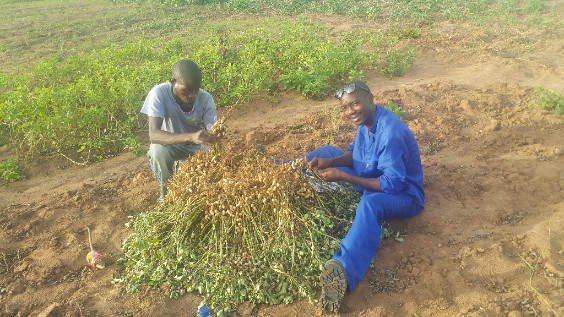From Malawi to Mozambique, Zuza wants to help farmers protect groundnut crop
By Allison Floyd
University of Georgia, Peanut & Mycotoxin Innovation Lab

Getting the most yield from a peanut crop has a lot to do with timing the harvest – not too early, not too late.
Emmanuel Zuza knows that peanuts don’t continue to get better with age, and is working to show through his research how much yield farmers lose when they leave the crop in the ground too long.
“Most of the farmers in Mozambique and Malawi base the timing of harvest on the defoliation of the plant, but my studies indicate that defoliation may just show that the plant was diseased,” said Zuza, who hopes to finish a master’s degree in crop protection at Eduardo Mondlane University in Maputo, Mozambique, this fall.
It’s a common misconception with smallholder farmers in sub-Saharan Africa that defoliation is a sign of peanut maturation. Actually, defoliation from fungal diseases may prevent the plant from reaching its optimal maturity and weaken the plant to the point of making the pods more likely to stay in the ground when harvested, reducing the overall yield and quality of the harvest.
But, peanuts grow underground, so it’s hard to convince a farmer of facts he can’t see.
“For farmers here, it is very important for them to actually know that they shouldn’t just look at the yellowing of leaves and the falling of leaves, but know the planting date and the expected time of harvest. That’s key for a good yield and less aflatoxin in the crop,” Zuza said.
In his research project, Zuza planted three Spanish varieties in two locations (Nampula and Mapupulo, Northern Mozambique) and tested three harvest dates. Late harvest is common in both regions where Zuza planted and farmers traditionally get around 400-600 kg/ha.
Harvesting 10 days before physiological maturity, at maturity and 10 days after maturity, Zuza found the pattern he expected: Yield increased toward maturity and then dropped off. But he didn’t expect how sharply it would drop.
Comparing the number of pods 10 days after maturity to the number 10 days before maturity, Zuza found nearly the same yield in some plots. Pests, sprouting seeds and pods breaking into the soil dramatically reduced the number of pods collected 10 days after maturity. Across the varieties and locations, late harvest cost 30.7% to 36.6% of the pods, compared to timely harvest.
Farmers are starting to understand the proper time to harvest and the cost of waiting too late. But with more crops perceived to be more valuable in the field, many growers put groundnut harvest at the end of their priority list when labor is scarce, not realizing how much potential profit they are losing. Nor do they realize the increase in risk of aflatoxin, a second aspect of Zuza’s work on late harvesting.
“The loss is huge. Whether you are growing for commercial or food purposes, that’s huge,” Zuza said. “Planning ahead to harvest at the correct physiological maturity, the farmer can save some of that profit.”
Awareness about the cost is key for African farmers to change their traditional practices, he said.
Zuza grew up in rural southern Malawi, where the family farm paid his university fees through proceeds from groundnuts, maize, soybeans, and pigeon peas.
He returns to the farm during busy seasons and intends to work in agricultural extension after graduation.
“Most of the time, I am there to help out, but sometimes in the wet season, if there are pests and diseases, I am able to help out,” he said. Crop protection has always interested him and is where he plans to invest his time.
“I want to work in crop protection extension. I know there are lots of people doing (plant) breeding, and that’s important. But, what about after those varieties are introduced?
“You give those varieties to the farmer, but they have to protect their farm from pests and diseases. I want to help farmers interpret the best control mechanisms to have good yields,” he said. “That not only makes us more food secure; it also brings more money to the farmer.”
Published July 05, 2016
